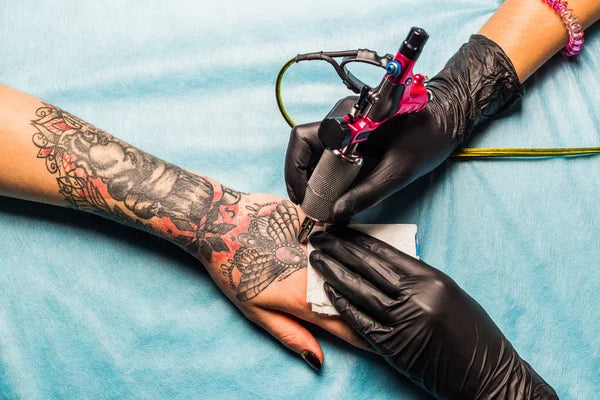Electrum's tattoo culture blog
Electrum's Tattoo Culture Blog
The Business of Tattooing - Why You’re Not Booking — and How to Fix It Fast
So Your Books Aren’t Full - Now What?Here’s the truth: most tattoo artists aren’t struggling because of their art.They’re struggling because their systems, communication, and visibility are letting them down. If you’re feeling burnt out, under-booked, or just over chasing clients - here are 4 things you can start doing today to fix that.
Read moreThe Business of Tattooing - Micro-Trends, Macro-Money: How Styles Like “Ignorant Tattoos,” “Fine-Line,” or “Sticker Sleeves” Affect Long-Term Sustainability
Micro-trends can be incredible for visibility and fast cash, but they’re not a business model by themselves. The smartest artists use trends as leverage: they attract new clients, grow social reach, and then transition those clients into bigger, more sustainable work.
The Business of Tattooing - Creating a Tattoo Studio Culture That Retains Top Talent
As a seasoned tattoo artist and studio owner, I've seen firsthand how the right culture transforms a tattoo studio from merely a workplace into a thriving creative community. Attracting skilled artists is one thing; retaining them long-term is another challenge altogether. Here's how you can build an environment that motivates your artists to stay and grow alongside your business.
The Business of Tattooing - How to price your tattoos without undervaluing your art and time
As a tattoo artist, pricing your work can be one of the most challenging aspects of the job. Setting rates that reflect your skill, experience, and time is essential—not just for your income but for establishing your value in the industry. Undervaluing your art can lead to burnout, frustration, and financial instability. Here’s how to price your tattoos confidently and fairly without selling yourself short.
The Business of Tattooing - Video Marketing for Tattoo Artists: Show, Don't Just Tell
In a world dominated by visuals, tattoo artists have a unique advantage. Your art is inherently visual, and video marketing is one of the most powerful ways to share your creative process, showcase your skills, and build authentic connections with potential clients. Rather than simply telling people what you do, video allows you to show them the passion, precision, and personality behind every piece of ink. Let’s dive into why video marketing matters and how you can make it work for you.
The Business of Tattooing - Booked Out for 6 Months”: The Hidden Financial & Emotional Risks Behind the Flex
In today’s tattoo industry, being “booked out for months” is the ultimate flex. It signals demand, status, and credibility. But behind the humblebrag? There are hidden costs—financial, emotional, and cultural—that most artists don’t talk about.
The Business of Tattooing - How Tattoo Artists Can Create a Safer and More Inclusive Space for ALL Clients
In the world of body art, a tattoo isn’t just ink and skin—it’s a deeply personal expression of identity, culture, and history. As more clients seek tattoo artists who understand and respect their identities, ensuring a welcoming and inclusive environment for diverse clients has never been more important. By implementing a few thoughtful practices, you can help your clients feel seen, respected, and cared for. Here are some actionable steps you can take as a tattoo artist to help foster a positive experience for every individual who walks through your door.
How to Build a Tattoo Flash Book (That Doesn’t Suck)
So you’ve got a few designs, a sketchbook full of half-finished ideas, and a burning desire to be taken seriously.Time to build a flash book, right? Yes—but let’s make it one that doesn’t suck. Whether you’re an apprentice or a new artist, your flash book is more than just “cool art”—it’s your handshake, your pitch, your silent sales rep sitting on the counter waiting to get picked. Here’s how to make one that clients actually want to pick from. 1. Know the Purpose of Your Flash Book Your flash isn’t just for show.It should: Help clients choose something from your style Show off your linework and saturation skills Give you consistent practice with designs you love Make it easy to say “No customs, flash only this month” A good flash book = fewer chaotic last-minute redesigns + more tattoos you actually want to do. 2. Pick a Style and Stick to It Flash isn’t where you show off your range.It’s where you define your voice. If your flash book has: A cute kawaii frog A biomech skull A photorealistic lion A fine line flowerYou don’t look versatile—you look like you’re still figuring out who you are. Pick a vibe. Commit. Build around that. 3. Design for Skin, Not Just Aesthetics Tattoo flash has to be tattooable. Not just pretty. When designing: Use bold, clean linework Avoid excessive tiny detail that won’t heal well Think about placement—arm, thigh, ankle—does it fit? Use black to create depth and contrast, even in color pieces If it wouldn’t hold up in five years, it doesn’t belong in your book. 4. Organize It Logically Nobody wants to flip through chaos. Try organizing your book by: Theme (flowers, critters, daggers, spooky babes) Size or pricing tiers Color vs. black and grey Label clearly. Include dimensions, prices (if applicable), and whether designs are repeatable or one-and-done. 5. Print It Professionally (or Neatly AF) Yes, you can use an iPad or a nice binder, but don’t make it look like a high school art project. Options: Laminated printouts in a sleek portfolio binder A branded iPad flash book for easy browsing Printed zines you hand out or sell at events Use consistent formatting. Add your name/handle on each page. Sign your flash. 6. Update It Regularly Your style evolves. Your skill improves.That flash sheet you loved 6 months ago? Might not hit the same now. Schedule time every month or so to: Retire old pieces Redraw or tweak old designs Add new ones you’re excited about Make seasonal or themed sheets (Halloween flash, Pride flash, etc.) 7. Make It Easy to Choose from The best flash books don’t intimidate people.They spark joy and say: “Pick me. I’m gonna look hot on your leg.” Don’t overload your pages. Keep the layout clean.Highlight your favorite pieces.And make sure someone who knows nothing about tattoos could flip through and fall in love. Bonus: What to Avoid Sloppy linework (clients notice) Unclear pricing or sizing Ripping other artists’ flash (you will get called out) Adding customs into the flash book (keep them separate) TL;DR: Flash That Sells = Art You’d Want Tattooed on Your Best Friend Because if you’re going to spend hours drawing it, printing it, and showing it off—you deserve to actually tattoo it. Start small. Stay consistent. Keep refining.
The Business of Tattooing - How to Attract Your Dream Tattoo Clients: A Step-by-Step Guide
Every tattoo artist dreams of a steady stream of clients who love their work, respect their time, and align perfectly with their artistic style. But attracting your dream clients doesn’t happen by chance - it’s all about intentional branding, marketing, and building relationships. Here’s how to make it happen:
The Business of Tattooing - The Death of Walk-Ins? Or the Beginning of a Comeback?
Walk-ins are one of the most iconic parts of tattoo history. For decades, they defined shop culture: neon “Tattoo” signs glowing, clients flipping through flash, and spontaneous choices made in the moment. It was fast, accessible, and social—tattooing as part of the street. But today’s industry looks different. Between Instagram portfolios, booking apps, and specialized styles, most artists are booked weeks (sometimes months) in advance. The romantic idea of strolling in for a quick piece feels almost like a relic.
The Business of Tattooing - How branding can set you apart as a tattoo artist
As a tattoo artist, creating a cohesive brand goes far beyond simply showcasing your tattoo style. Your brand is the unique, memorable experience clients associate with you, from the way you interact to your studio's atmosphere and even the aftercare you provide. In 2025, clients are seeking artists who not only create great tattoos but also deliver an experience that reflects their own personalities, values, and aesthetics. Here’s how to build a cohesive brand that makes your work unforgettable and helps you attract more clients.
The Business of Tattooing - The Psychology of Repeat Clients: Why They Come Back (or Don’t)
Every tattooer knows the thrill of a getting a new client - but repeat clients?! They’re the backbone of a sustainable career, returning clients not only bring steady income, they also become your biggest advocates, sending you referrals and posting your work on social media. So why do some clients stay in a long term relationship with one artist for years while others bounce? The answer is partially customer service and the other part: psychology.
If Your Art Is a Trend, So Is Your Tattooing Career
Tattoo trends are shaped by a mess of influences—everything from celebrity culture to the gravitational pull of social media algorithms. The problem? Trends move faster than ink heals. When artists hitch their entire business to the latest micro-style, they’re gambling with burnout, client regret, and financial instability. Let’s break down why.
About the Electrum Blog:
From tattooing's past to the future, the team of artists and shop owners at Electrum share their perspectives and knowledge on everything tattoo industry.
A few of the things you'll find in our blog posts:
- Business and Industry Insights: advice and ideas for tattoo business growth, current industry trends and strategies for attracting clients, whilst managing a full schedule.
- Compliance and Safety: Information regarding regulatory compliance and our mission to produce safe, compliant inks.
- Product Information: Details about our specific products.
- Interviews and Events: Discussions and recaps from industry events.















